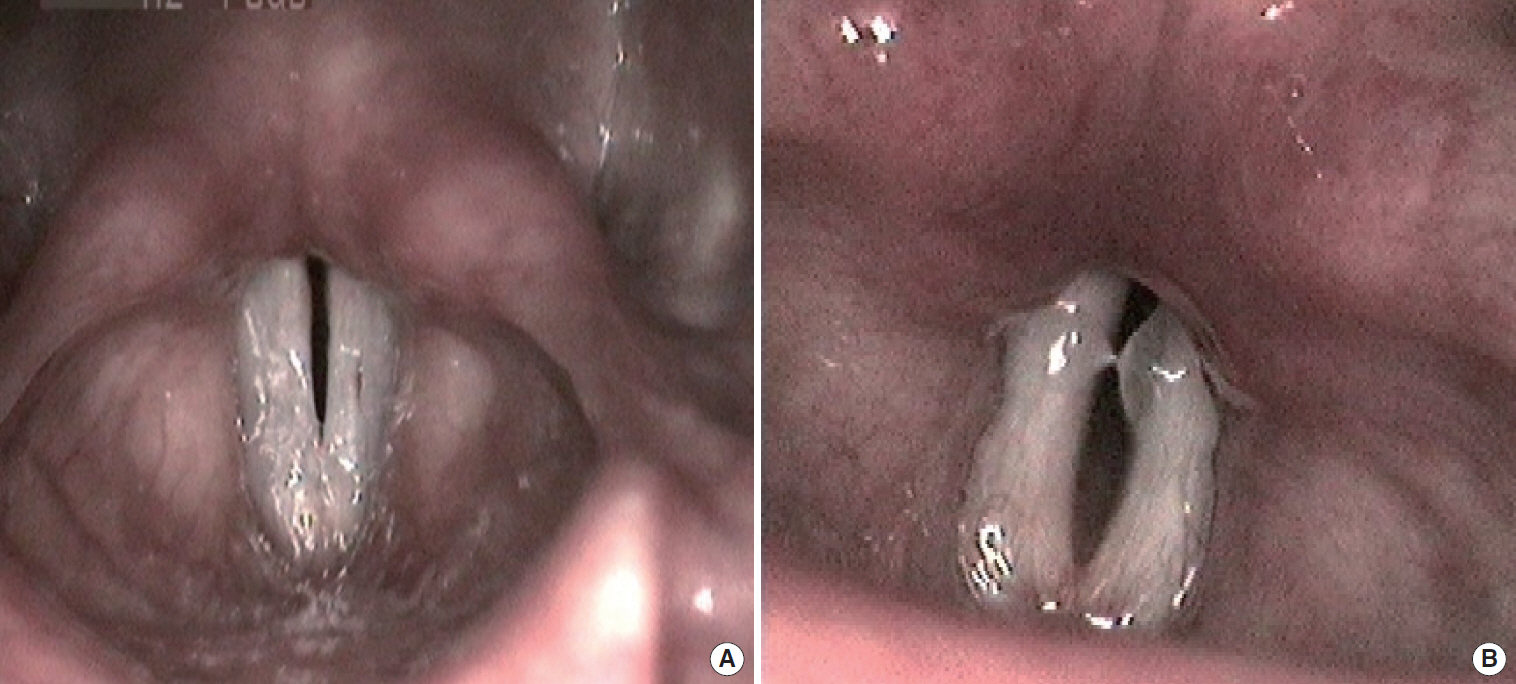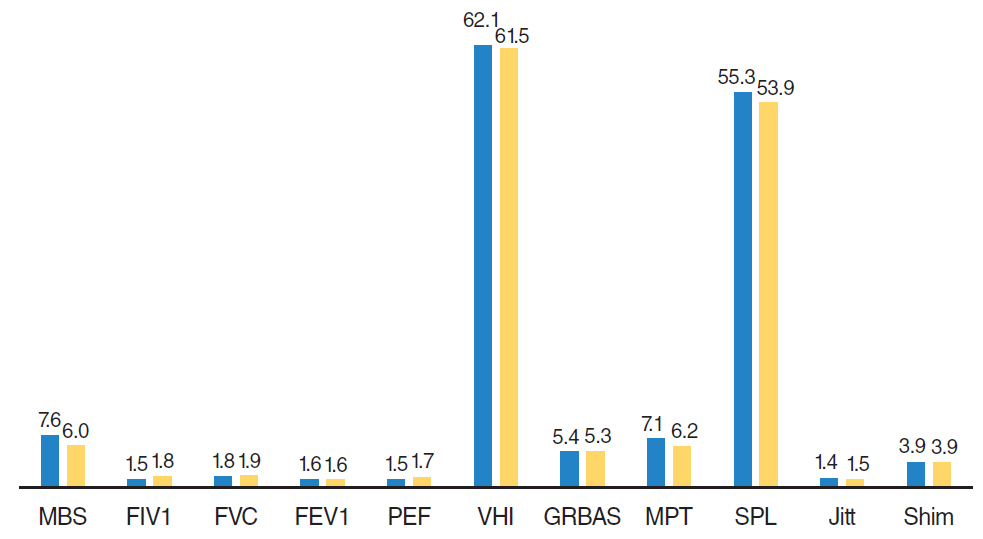Clin Exp Otorhinolaryngol.
2017 Jun;10(2):193-202. 10.21053/ceo.2016.00241.
Electromyography-Guided Botulinum Toxin Injection Into the Cricothyroid Muscles in Bilateral Vocal Fold Abductor Paralysis
- Affiliations
-
- 1Department of Otolaryngology, Adnan Menderes University Medical School, Aydin, Turkey. iskebaha@gmail.com
- 2Department of Neurology, Ege University Medical School, Izmir, Turkey.
- 3Department of Otolaryngology, Ege University Medical School, Izmir, Turkey.
- 4Department Chest Diseases, Ege University Medical School, Izmir, Turkey.
- KMID: 2380440
- DOI: http://doi.org/10.21053/ceo.2016.00241
Abstract
OBJECTIVES
Bilateral vocal fold abductor paralysis (BVFAP) both deteriorates quality of life and may cause life-threatening respiratory problems. The aim of this study was to reduce respiratory symptoms in BVFAP patients using cricothyroid (CT) botulinum toxin (BTX) injection.
METHODS
Before and 2 weeks and 4 months after bilateral BTX injection into the CT muscles under electromyography; alterations in respiratory, acoustic, aerodynamic and quality of life parameters were evaluated in BVFAP patients with respiratory distress. For the respiratory evaluation modified Borg scale and spirometry, for the voice and aerodynamic evaluations Voice Handicap Index-30 (VHI-30), GRBAS, acoustic analysis (sound pressure level, F0, jitter%, shimmer%, noise-to-harmonic ratio) and maximum phonation time and for the quality of life assessment Short Form-36 (SF-36) form were used.
RESULTS
All patients were female with a mean age of 47±8.1 years. There was a mean time of 11.8±5.5 (minimum 2, maximum 23) months between BVFAP development and BTX injection. In all cases, other than one case with unknown aetiology, the cause of vocal fold paralysis was prior thyroid surgery. In total 18.6±3.1 units of BTX were applied to the CTs. In the preinjection period, and the 2nd week and 4th month after injection, the Borg dyspnea scale was 7.3/5.3/5.0, FIV1 (forced inspiratory volume in one second) was 1.7/1.7/1.8 L, peak expiratory flow (PEF) was 1.4/1.7/2.1 L/sec, maximum phonation time was 7.0/6.4/6.2 seconds and VHI-30 was 63.2/52.2/61.7 respectively. There was no significant alteration in acoustic analysis parameters. Many of the patients reported transient dysphagia within the first week. There were insignificant increases in SF-36 sub-scale values.
CONCLUSION
After BTX injection, improvements in the mean Borg score, PEF and FIV1 values and SF-36 sub-scale scores showed the restricted success of this approach. This modality may be kept in mind as a transient treatment option for patients refused persistent tracheotomy or ablative airway surgeries.
MeSH Terms
Figure
Reference
-
1. Zealear DL, Billante CR. Neurophysiology of vocal fold paralysis. Otolaryngol Clin North Am. 2004; Feb. 37(1):1–23.
Article2. Myssiorek D. Recurrent laryngeal nerve paralysis: anatomy and etiology. Otolaryngol Clin North Am. 2004; Feb. 37(1):25–44.
Article3. Misiolek M, Waler J, Namyslowski G, Kucharzewski M, Podwinski A, Czecior E. Recurrent laryngeal nerve palsy after thyroid cancer surgery: a laryngological and surgical problem. Eur Arch Otorhinolaryngol. 2001; Nov. 258(9):460–2.
Article4. Hillel AD, Benninger M, Blitzer A, Crumley R, Flint P, Kashima HK, et al. Evaluation and management of bilateral vocal cord immobility. Otolaryngol Head Neck Surg. 1999; Dec. 121(6):760–5.
Article5. Dursun G, Gokcan MK. Aerodynamic, acoustic and functional results of posterior transverse laser cordotomy for bilateral abductor vocal fold paralysis. J Laryngol Otol. 2006; Apr. 120(4):282–8.
Article6. Misono S, Merati AL. Evidence-based practice: evaluation and management of unilateral vocal fold paralysis. Otolaryngol Clin North Am. 2012; Oct. 45(5):1083–108.7. Blitzer A, Sulica L. Botulinum toxin: basic science and clinical uses in otolaryngology. Laryngoscope. 2001; Feb. 111(2):218–26.
Article8. Zalvan CH, Blitzer A. Using botulinum toxin therapy in the laryngopharynx. Oper Tech Otolaryngol Head Neck Surg. 2004; Jun. 15(2):86–9.
Article9. Benninger MS, Hanick A, Hicks DM. Cricothyroid muscle botulinum toxin injection to improve airway for bilateral recurrent laryngeal nerve paralysis, a case series. J Voice. 2016; Jan. 30(1):96–9.
Article10. Ongkasuwan J, Courey M. The role of botulinum toxin in the management of airway compromise due to bilateral vocal fold paralysis. Curr Opin Otolaryngol Head Neck Surg. 2011; Dec. 19(6):444–8.
Article11. Andrade Filho PA, Rosen CA. Bilateral vocal fold paralysis: an unusual treatment with botulinum toxin. J Voice. 2004; Jun. 18(2):254–5.12. Cohen SR, Thompson JW. Use of botulinum toxin to lateralize true vocal cords: a biochemical method to relieve bilateral abducto r vocal cord paralysis. Ann Otol Rhinol Laryngol. 1987; Sep-Oct. 96(5):534–41.13. Ekbom DC, Garrett CG, Yung KC, Johnson FL, Billante CR, Zealear DL, et al. Botulinum toxin injections for new onset bilateral vocal fold motion impairment in adults. Laryngoscope. 2010; Apr. 120(4):758–63.
Article14. Daniel SJ, Cardona I. Cricothyroid onabotulinum toxin A injection to avert tracheostomy in bilateral vocal fold paralysis. JAMA Otolaryngol Head Neck Surg. 2014; Sep. 140(9):867–9.
Article15. Mahler DA, Horowitz MB. Clinical evaluation of exertional dyspnea. Clin Chest Med. 1994; Jun. 15(2):259–69.
Article16. Kilic MA, Okur E, Yildirim I, Ogut F, Denizoglu I, Kizilay A, et al. Reliability and validity of the Turkish version of the Voice Handicap Index. Kulak Burun Bogaz Ihtis Derg. 2008; May-Jun. 18(3):139–47.17. Eadie T, Sroka A, Wright DR, Merati A. Does knowledge of medical diagnosis bias auditory-perceptual judgments of dysphonia? J Voice. 2011; Jul. 25(4):420–9.
Article18. Ware JE Jr, Sherbourne CD. The MOS 36-item short-form health survey (SF-36). I. Conceptual framework and item selection. Med Care. 1992; Jun. 30(6):473–83.19. Yilmaz T, Suslu N, Atay G, Ozer S, Gunaydın RO, Bajin MD. Comparison of voice and swallowing parameters after endoscopic total and partial arytenoidectomy for bilateral abductor vocal fold paralysis: a randomized trial. JAMA Otolaryngol Head Neck Surg. 2013; Jul. 139(7):712–8.20. Holden PK, Vokes DE, Taylor MB, Till JA, Crumley RL. Long-term botulinum toxin dose consistency for treatment of adductor spasmodic dysphonia. Ann Otol Rhinol Laryngol. 2007; Dec. 116(12):891–6.
Article21. Merati AL, Halum SL, Smith TL. Diagnostic testing for vocal fold paralysis: survey of practice and evidence-based medicine review. Laryngoscope. 2006; Sep. 116(9):1539–52.
Article22. Cohen SR, Thompson JW, Camilon FS Jr. Botulinum toxin for relief of bilateral abductor paralysis of the larynx: histologic study in an animal model. Ann Otol Rhinol Laryngol. 1989; Mar. 98(3):213–6.
Article23. Smith ME, Park AH, Muntz HR, Gray SD. Airway augmentation and maintenance through laryngeal chemodenervation in children with impaired vocal fold mobility. Arch Otolaryngol Head Neck Surg. 2007; Jun. 133(6):610–2.
Article24. Niamtu J 3rd. Botulinum toxin A: a review of 1,085 oral and maxillofacial patient treatments. J Oral Maxillofac Surg. 2003; Mar. 61(3):317–24.
Article25. Tatar EC, Sahin M, Demiral D, Bayir O, Saylam G, Ozdek A, et al. Normative values of voice analysis parameters with respect to menstrual cycle in healthy adult Turkish women. J Voice. 2016; May. 30(3):322–8.
Article26. Neuenschwander MC, Pribitkin EA, Sataloff RT. Botulinum toxin in otolaryngology. In : Sataloff RT, editor. Treatment of voice disorders. San Diego: Plural Publishing Inc.;2005. p. 167–77.
- Full Text Links
- Actions
-
Cited
- CITED
-
- Close
- Share
- Similar articles
-
- Clinical Application of Botulinum Toxin to Contact Granuloma and Vocal Nodule
- Botulinum Toxin for Upper Esophageal Sphincter and Larynx
- Botulinum Toxin A Treatment for the Improvement of Hand Function in Spastic Hemiplegia
- Technical Review of How to Determine the Exact Location of Needle Tip During Office-Based Injection Augmentation of the Vocal Folds Via Cricothyroid Approach
- A Case of Palatal Myoclonus Tinnitus Treated with Botolinum Toxin Injection



